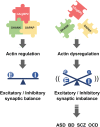nArgBP2-SAPAP-SHANK, the core postsynaptic triad associated with psychiatric disorders
- PMID: 29628500
- PMCID: PMC5938024
- DOI: 10.1038/s12276-017-0018-5
nArgBP2-SAPAP-SHANK, the core postsynaptic triad associated with psychiatric disorders
Abstract
Despite the complex genetic architecture, a broad spectrum of psychiatric disorders can still be caused by mutation(s) in the same gene. These disorders are interrelated with overlapping causative mechanisms including variations in the interaction among the risk-associated proteins that may give rise to the specific spectrum of each disorder. Additionally, multiple lines of evidence implicate an imbalance between excitatory and inhibitory neuronal activity (E/I imbalance) as the shared key etiology. Thus, understanding the molecular mechanisms underlying E/I imbalance provides essential insight into the etiology of these disorders. One important class of candidate risk genes is the postsynaptic scaffolding proteins, such as nArgBP2, SAPAP, and SHANK that regulate the actin cytoskeleton in dendritic spines of excitatory synapses. This review will cover and discuss recent studies that examined how these proteins, especially nArgBP2, are associated with psychiatric disorders. Next, we propose a possibility that variations in the interaction among these proteins in a specific brain region might contribute to the onset of diverse phenotypes of psychiatric disorders.
Conflict of interest statement
The authors declare that they have no conflict of interest.
Figures



Similar articles
-
nArgBP2, a novel neural member of ponsin/ArgBP2/vinexin family that interacts with synapse-associated protein 90/postsynaptic density-95-associated protein (SAPAP).J Biol Chem. 1999 Oct 22;274(43):30914-8. doi: 10.1074/jbc.274.43.30914. J Biol Chem. 1999. PMID: 10521485
-
nArgBP2 as a hub molecule in the etiology of various neuropsychiatric disorders.BMB Rep. 2016 Sep;49(9):457-8. doi: 10.5483/bmbrep.2016.49.9.138. BMB Rep. 2016. PMID: 27530683 Free PMC article.
-
Synaptic Targeting and Function of SAPAPs Mediated by Phosphorylation-Dependent Binding to PSD-95 MAGUKs.Cell Rep. 2017 Dec 26;21(13):3781-3793. doi: 10.1016/j.celrep.2017.11.107. Cell Rep. 2017. PMID: 29281827
-
SAPAP Scaffold Proteins: From Synaptic Function to Neuropsychiatric Disorders.Cells. 2022 Nov 28;11(23):3815. doi: 10.3390/cells11233815. Cells. 2022. PMID: 36497075 Free PMC article. Review.
-
Shank postsynaptic scaffolding proteins in autism spectrum disorder: Mouse models and their dysfunctions in behaviors, synapses, and molecules.Pharmacol Res. 2022 Aug;182:106340. doi: 10.1016/j.phrs.2022.106340. Epub 2022 Jul 2. Pharmacol Res. 2022. PMID: 35792298 Review.
Cited by
-
Genome-wide profiling of DNA methylome and transcriptome in peripheral blood monocytes for major depression: A Monozygotic Discordant Twin Study.Transl Psychiatry. 2019 Sep 2;9(1):215. doi: 10.1038/s41398-019-0550-2. Transl Psychiatry. 2019. PMID: 31477685 Free PMC article.
-
Establishing a Mouse Model of NL3R617W-Associated Autism Spectrum Disorder for a Functional Study.Actas Esp Psiquiatr. 2025 Mar;53(2):253-266. doi: 10.62641/aep.v53i2.1780. Actas Esp Psiquiatr. 2025. PMID: 40071366 Free PMC article.
-
Cannabis use is associated with potentially heritable widespread changes in autism candidate gene DLGAP2 DNA methylation in sperm.Epigenetics. 2020 Jan-Feb;15(1-2):161-173. doi: 10.1080/15592294.2019.1656158. Epub 2019 Aug 26. Epigenetics. 2020. PMID: 31451081 Free PMC article.
-
Molecular architecture of postsynaptic Interactomes.Cell Signal. 2020 Dec;76:109782. doi: 10.1016/j.cellsig.2020.109782. Epub 2020 Sep 14. Cell Signal. 2020. PMID: 32941943 Free PMC article. Review.
-
Current challenges and possible future developments in personalized psychiatry with an emphasis on psychotic disorders.Heliyon. 2020 May 20;6(5):e03990. doi: 10.1016/j.heliyon.2020.e03990. eCollection 2020 May. Heliyon. 2020. PMID: 32462093 Free PMC article. Review.
References
-
- Bourgeron T. A synaptic trek to autism. Curr. Opin. Neurobiol. 2009;19:231–234. - PubMed
-
- Zoghbi HY. Postnatal neurodevelopmental disorders: meeting at the synapse? Science. 2003;302:826–830. - PubMed
-
- Benes FM, Berretta S. GABAergic interneurons: implications for understanding schizophrenia and bipolar disorder. Neuropsychopharmacology. 2001;25:1–27. - PubMed
Publication types
MeSH terms
Substances
LinkOut - more resources
Full Text Sources
Other Literature Sources
Medical

